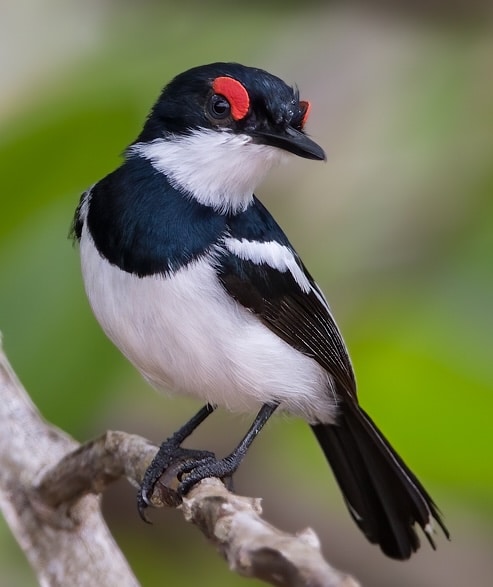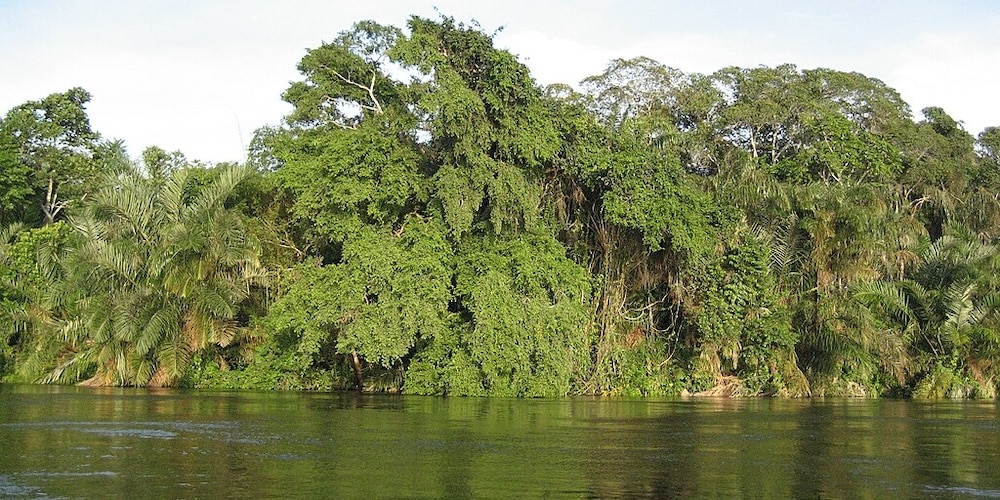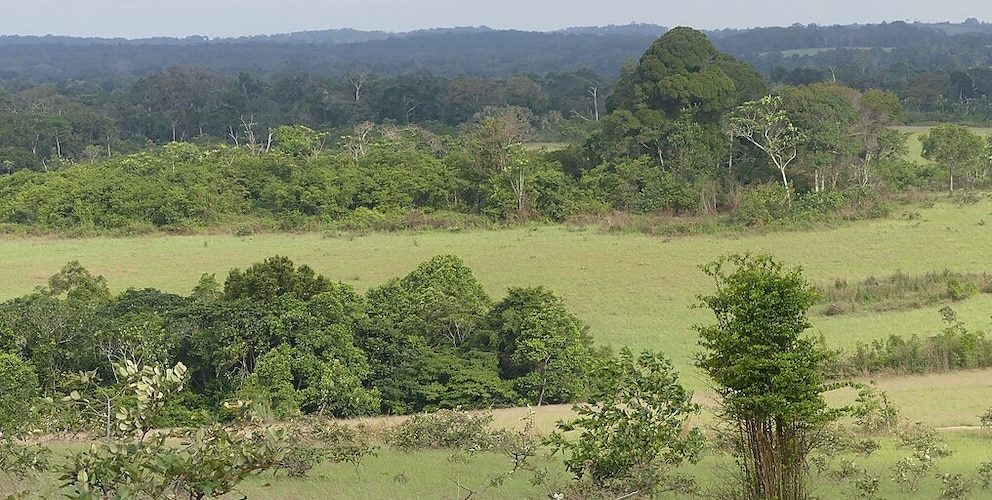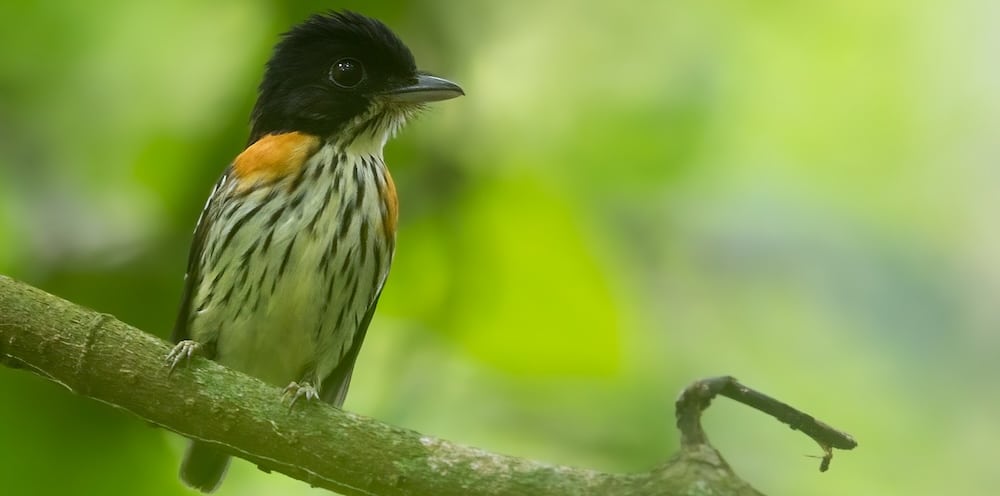Republic of the Congo

The Republic of the Congo, also known as Congo-Brazzaville, the Congo Republic or simply the Congo, is a country located on the western coast of Central Africa to the west of the Congo River. It covers an area of 342,000 km2 (132,000 square miles). It is bordered to the west by Gabon, to the northwest by Cameroon, to the northeast by the Central African Republic, to the southeast by the Democratic Republic of the Congo, to the south by the Angolan exclave of Cabinda, and to the southwest by the Atlantic Ocean. Its population is concentrated in the southwestern portion, leaving the areas of tropical jungle in the north virtually uninhabited. 70% of its total population (of 6.5 million people) lives in urban areas, namely 2.8 million in the capital Brazzaville, 1.5 million in Pointe-Noire, and the rest in one of the cities or villages lining the 534-kilometre (332 mi), railway which connects the two cities.
Congo is the fourth-largest oil producer in the Gulf of Guinea, providing the country a degree of prosperity, with political and economic instability in some areas and unequal distribution of oil revenue nationwide. Its economy is dependent on the oil sector. Christianity is the most widely professed faith in the country.

Alima River – © CC BY-SA 3.0 via Wikimedia Commons
Birding Congo-Brazzaville
The landscapes ranges from the savanna plains in the North Niari flooded forests, to the Congo River, to the rugged mountains and forests of Mayombe, and 170 km of beaches along the Atlantic coast. The southwest is a coastal plain for which the primary drainage is the Kouilou-Niari River; the interior of the country consists of a central plateau between 2 basins to the south and north. Forests are under increasing exploitation pressure. The country has four terrestrial eco-regions: Atlantic Equatorial coastal forests, Northwestern Congolian lowland forests, Western Congolian swamp forests, and Western Congolian forest-savanna mosaic. A large portion of the Republic of Congo is tropical rainforest. The forest is split into several sections, the first being low lying branches of large evergreen trees. The next level contains smaller trees and plants. Under that level lies bushes and ferns. The floor of this region consists of mainly ferns, vines, and roots that twist and turn throughout different vegetation. Roughly 69% of the country consists of forest areas.

Conkouati-Douli National Park – ©Stevy08 Public Domain via Wikimedia Commons
Since the country is located on the Equator, the climate is consistent year-round, with the average day temperature a humid 24 °C and nights generally between 16 °C and 21 °C. The average yearly rainfall ranges from 43 inches in the Niari Valley in the south to over 79 inches in central parts. The dry season is from June to August, while in the majority of the country, the wet season has two peaks, one in March to May and another in September to November.

Rufous-sided Broadbill Smithornis rufolateralis – ©Dubi Shapiro
There are 400 mammal species, over 700 bird species and 10,000 plant species (3,000 of which are unique to the Republic of Congo). Many parts of the country are covered in tropical rainforest, although some of the southern areas have been cleared by logging. The wider Congo River Basin has earned a global reputation for the variety of wildlife found inside its forests. Famously, the country has a population of c. 125,000 Western Lowland Gorillas Gorilla gorilla gorilla, whose isolation from humans has been largely preserved by inhospitable swamps. It is also home to Chimpanzees, Bonobos and other forest mammals such as Forest Elephant.
-
Number of bird species: 740
(As at February 2025)
-
Avibase
PDF ChecklistThis checklist includes all bird species found in Republic of the Congo , based on the best information available at this time. It is based on a wide variety of sources that I collated over many years. I am pleased to offer these checklists as a service to birdwatchers. If you find any error, please do not hesitate to report them. -
E-Bird
PDF ChecklistThis checklist is generated with data from eBird (ebird.org), a global database of bird sightings from birders like you. If you enjoy this checklist, please consider contributing your sightings to eBird. It is 100% free to take part, and your observations will help support birders, researchers, and conservationists worldwide. -
Wikipedia
Annotated ListThis is a list of the bird species recorded in the Republic of the Congo. The avifauna of the Republic of the Congo include a total of 733 species.
-
Birds of Western Africa
| By Nik Borrow & Ron Demey | Christopher Helm | 2014 | Edition 2 | Paperback | 592 pages, 266 plates with colour illustrations; colour distribution maps | ISBN: 9781472905680 Buy this book from NHBS.com -
Birds of Western and Central Africa
| By Ber van Perlo | Princeton University Press | 2003 | Paperback | 384 pages, 109 plates with colour illustrations; colour & b/w illustrations, 1500+ b/w distribution maps, colour maps | Out of Print | ISBN: 9780691007144 Buy this book from NHBS.com

Birds of Africa
Apple iOS | AndroidBirds of Africa was developed as an aid to conservation and is an asset of The African Bird Club. It is a guide to more than 2300 species of birds in 43 countries... Birds of Africa – an identification guide which in time will cover all the birds and countries in Africa. The latest version of this app is available to download for free from the App Store or Google Play.Organisations-
African Bird Club
WebpageThe Republic of the Congo has a bird list of over 600 species. Few birdwatchers, however, have visited the country and many parts are under-recorded. The political situation and safety concerns are such that this is likely to remain the case for some time. With such a wonderful range of habitats and a plethora of interesting species, one can only hope that opportunities to visit will increase in the near future. -
West African Ornithological Society
WebpageThe West African Ornithological Society grew out of the Nigerian Ornithologists’ Society, which was founded in February 1964. Its object is to promote scientific interest in the birds of West Africa and to further the region’s ornithology, mainly by means of its journal Malimbus (formerly the Bulletin of the Nigerian Ornithologists’ Society). This journal is biannual and bilingual, a unique feature in Africa.The West African Ornithological Society grew out of the Nigerian Ornithologists’ Society, which was founded in February 1964. Its object is to promote scientific interest in the birds of West Africa and to further the region’s ornithology, mainly by means of its journal Malimbus (formerly the Bulletin of the Nigerian Ornithologists’ Society). This journal is biannual and bilingual, a unique feature in Africa. -
Wildlife Conservation Society - Congo
WebpageThe Republic of Congo encompasses an extraordinary diversity of wildlife, habitats and culture; including one of the largest continuous stretches of intact rainforest in central Africa and the indigenous forest people who call it home. The Wildlife Conservation Society’s largest country program has been working to save Congo’s wildlife and wild places for almost three decades. Protecting this astonishing biodiversity means saving wild places that sustain the local people, protect natural resources, and buffer global climate change.
Reserves-
*Protected areas of the Republic of the Congo
InformationSatellite ViewInteractive list of Biosphere Reserves, National Parks and Ramsand sites... -
BR Dimonika Biosphere Reserve
InformationSatellite ViewThe 136,000 hectares (530 sq mi) reserve is located in the central Mayombe mountain chain about 50 km (31 mi) from the Atlantic coast. The reserve has been designated an Important Bird Area (IBA). -
Important Bird Areas
InformationSatellite ViewThe avifauna of the Congo is still incompletely documented and large parts of the country including the Chaillu massif and the Likouala swamp-forests remain unexplored. Wetlands are mainly in the form of seasonally flooded forests which are not attractive to migratory waterbirds, while coastal and inland mudflats are very small. In general, the position of the country on the southern edge of the Guinea-Congo forest block means that it is of little importance as a refuge for migratory species -
NP Conkouati-Douli
InformationSatellite ViewCDNP is the most biodiverse park in the country and includes the only marine protected area in Congo. It is a priority site for great apes in the IUCN great ape conservation action plan because it includes around 8,000 central chimpanzees (Pan troglodytes) and 2,000 Western lowland gorillas (Gorilla gorilla gorilla). The park also houses some 1000 forest elephants (Loxodonta africana cyclotis) and is a RAMSAR site for its importance for migratory and wetland birds. Its beaches are amongst the most important in the world for nesting of leatherback turtles (Dermochelys coriacea) and 5 species of marine turtles visit the beaches. -
NP Nouabalé-Ndoki
InformationSatellite ViewSituated in the north of the Republic of Congo (Congo-Brazzaville); the Nouabalé-Ndoki National Park was created in 1993 to conserve, in its natural state, one of the last examples of an untouched wilderness in the world. The Nouabalé-Ndoki National Park is one of the largest parks in the forested regions of central-west Africa, and contains almost 2% of all Congo's forests… -
NP Ntokou-Pikounda
InformationSatellite ViewNtokou-Pikounda National Park is a 4,572-square-kilometre (1,130,000-acre) protected area in the Congo Basin of the Republic of the Congo. The park also has an estimated 8,000 forest elephants and 950 chimpanzees. -
NP Odzala-Kokoua
InformationSatellite ViewOdzala-Kokoua National Park is some 13 600 square kilometres (1 360 million hectares) of pristine rainforest and is an integral part of both the Congo Basin and the TRIDOM Transfrontier Park overlapping Gabon, Congo and Central African Republic. Approximately 440 bird species have been recorded in the park. Species include the African fish eagle, black-backed cisticola, black-throated apalis, black-winged pratincole, eastern wattled cuckooshrike, forest robin, forest wood hoopoe, great snipe, green pigeon, grey parrot, grey-headed broadbill, lesser kestrel, Pel's fishing owl, pied kingfisher, red-capped crombec, red-throated cliff swallow, Uganda woodland warbler, and yellow-capped weaver. Herons, hornbills, and kingfishers are also present, including the goliath heron, black dwarf hornbill, and giant kingfisher
Sightings, News & Forums-
eBird
SightingseBirding This Month
Guides & Tour Operators-
Nature Travel Birding
Tour OperatorCongo Birding Tour Overview (ODZALA Immersion) – An epic adventure in rainforests, savannahs, rivers, mineral-rich baïs and swamps... -
NatureTrek
Tour OperatorAn 11-day holiday to the Republic of Congo in search of Western Lowland Gorillas and the other wildlife of this exciting and little-visited country. -
Rainbow Tours
Tour OperatorHome to the Western lowland gorilla, the Republic of Congo (not to be confused with the DRC) is emerging as the best place to see these magnificent creatures. The vast tropical interior is also home to forest elephant (a smaller species of elephant), buffalo, Sitatunga, Bongo, 11 other primates including wild chimpanzees and over 430 bird species. Our Congo wildlife holidays are based in the Odzala-Kokoua National Park, which is located in the second largest tropical rainforest in the world. -
Wilderness Explorers
Tour OperatorBirding Tours and Safaris in Republic of Congo
Trip Reports-
2010 [09 September] - Sjef Öllers - Cameroon, Congo and Central African Republic
PDF Report...The birding had many ups and down: not seeing bare-cheeked trogon, Sangha robin and rufous-sided broadbill was very disappointing, but we had excellent views of Congo serpent eagle, African finfoot and many hornbill species. Undoubtedly, the birding highlight of the tour was a trip into unexplored territory with Rod Cassidy. At a magical place in the rainforest with a cascading waterfall and several steep rock faces we found an unknown and active breeding site for red-headed picathartes with at least seven active nests. We had unforgettable views of these near-mythical forest birds... -
2017 [08 August] - John Melton Mammals
ReportBeing the second largest area of tropical rainforest on earth, the Congo Basin offers some of the most exciting, different and off the beaten track wildlife watching in Africa. -
2019 [09 September] - Mathias D'haen
PDF ReportI travelled to Bayanga by a route that seems logic, yet which I have not seen described in any other trip report so far. Travelling from Ouesso/Bomassa allows combining Dzanga-Ndoki NP with Odzala NP or Nouabale Ndoki NP. We (my partner and myself...
-
Fatbirder - linking birders worldwide...
Skip to content
